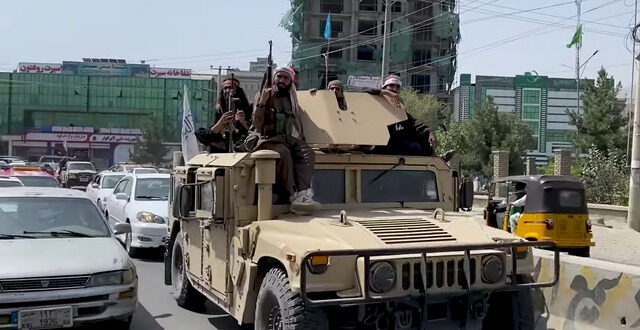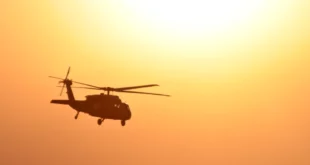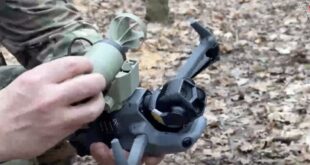A thriving black market arms bazaar has emerged in Afghanistan, where the Taliban control the sale of American weapons that were abandoned inside the country two years ago, according to reports.
An M-4 rifle in good condition is a status symbol with a $2,400 price tag, while a Pakistan-made AK-47 can be bought for $130, one analyst notes.
American weapons seized by the Taliban following the August 2021 withdrawal of U.S. forces from Afghanistan continue to show up outside the country.
READ MORE: Pakistani Taliban Tell Fighters to Resume Nationwide Terror Attacks
Last month, an Israeli commander speaking on condition of anonymity told Newsweek magazine that U.S. small arms captured in Afghanistan had ended up with Palestinian groups in the Gaza Strip.
American arms left in Afghanistan have also been turning up in neighboring Pakistan and elsewhere.
The Taliban deny this.
“We seriously reject the claim of some circles in the United States that the Islamic Emirate has sold the weapons and equipment left by the American forces in Afghanistan to other sources,” Islamic Emirate of Afghanistan spokesman Zabihullah Mujahid tweeted on July 10.
“The truth is that after the expulsion of the foreign forces (from Afghanistan), and full control of Islamic Emirate, equipment and vehicles are stored and saved in depots, and no one is allowed to smuggle or sell even a single weapon.”
That is false.
While reporting suggests the Taliban have tightened control over their U.S. weapons stocks, Taliban members have been directly implicated in the sale of U.S. armaments on the black market.
When U.S. forces left Afghanistan in August 2021, ending two decades of war, Afghan security forces collapsed. This allowed the Taliban, which took over Afghanistan, to capture large quantities of small arms and other military equipment.
In August 2022, the U.S. Department of Defense estimated “that U.S.-funded equipment valued at $7.12 billion was in the inventory of the former Afghan government when it collapsed, much of which was seized by the Taliban. This included military aircraft, ground vehicles, weapons and other military equipment.”
In November 2021, The New York Times spoke with weapons dealers in Kandahar, the province in southern Afghanistan that is the Taliban’s home base. The dealers were openly selling American weapons, some of which had been acquired by Taliban fighters.
The gun merchants in Kandahar said the Taliban had permitted some of their fighters to sell the small arms they seized after overrunning bases of the former Afghan government forces. Other weapons were confiscated and handed over to Taliban commanders.
In September 2021, France 24 quoted a Kandahar vendor who identified himself as Murtaza as saying: “We bought all these things from the Taliban after they conquered the Afghan army base. Now, we bring them to the market to sell.”
The dealers who spoke with The New York Times told the paper that many gun dealers had smuggled U.S. weapons to Pakistan. A former Taliban commander living in Kandahar said he had introduced a Pakistani arms dealer seeking pistols, rifles, night-vision goggles and other U.S. equipment to a local gun merchant.
Such military hardware has turned up in the hands of Taliban-aligned militants fighting Pakistani government forces.
In March, Radio Free Europe/Radio Liberty (RFE/RL), a VOA sister organization, reported that members of the Tehrik-e Taliban Pakistan (TTP) militant group had acquired U.S.-manufactured M16 machine guns, M4 assault rifles, night-vision goggles and military communications gear.
The TTP is organizationally separate from the Afghan Taliban but “inspired” by it.
In a joint update published earlier this month, Small Arms Survey, a Geneva-based independent research project focusing on small arms and armed violence, and the U.S.-based Afghan Peace Watch nongovernmental organization, reported that the Taliban had tightened control over large stockpiles of U.S. arms and small-scale smuggling.
Still, they said “arms smuggling” and “civilian arms sales” were continuing “where it suits local Taliban officials to collect taxes on these activities,” adding that “unauthorized, clandestine arms trafficking is also taking place.”
In late 2022, Afghan Peace Watch conducted field investigations in three Afghan provinces — Helmand, Kandahar, and Nangarhar. It interviewed weapons smugglers, low-level Taliban fighters, local Taliban officials, ex-members of the previous Afghan government’s security forces and security experts on Afghanistan.
Small Arms Survey and Afghan Peace Watch jointly reported that research findings confirmed “the presence of weapons markets” in Afghanistan-Pakistan border areas and indicated “ongoing cross-border weapons smuggling” despite “an upsurge in weapons seizures” by Afghan Taliban authorities.
Asfandyar Mir, a South Asia expert at the U.S. Institute of Peace, told Foreign Policymagazine “[t]he Taliban likely control and tax the new black market [on arms].”
U.S. arms have reportedly also ended up in Kashmir, the northernmost part of the Indian subcontinent where India and Pakistan have been engaged in a decades-long territorial dispute.
In January, authorities in India-controlled Kashmir told NBC News that U.S. arms, including M4 and M16 rifles, has been recovered from the Pakistani-based militant groups Jaish-e-Mohammad and Lashkar-e-Taiba, which are fighting to assert Pakistani control over Kashmir.
Militants from both groups have fought alongside or trained Taliban forces in Afghanistan.
In March, the online newspaper Kabul Now reported that various Taliban factions had periodically been at odds over the smuggling operations, reflecting a potential struggle for status and power within the organization.
Reported by VOA
 Soldier of Fortune Magazine The Journal of Professional Adventurers
Soldier of Fortune Magazine The Journal of Professional Adventurers






